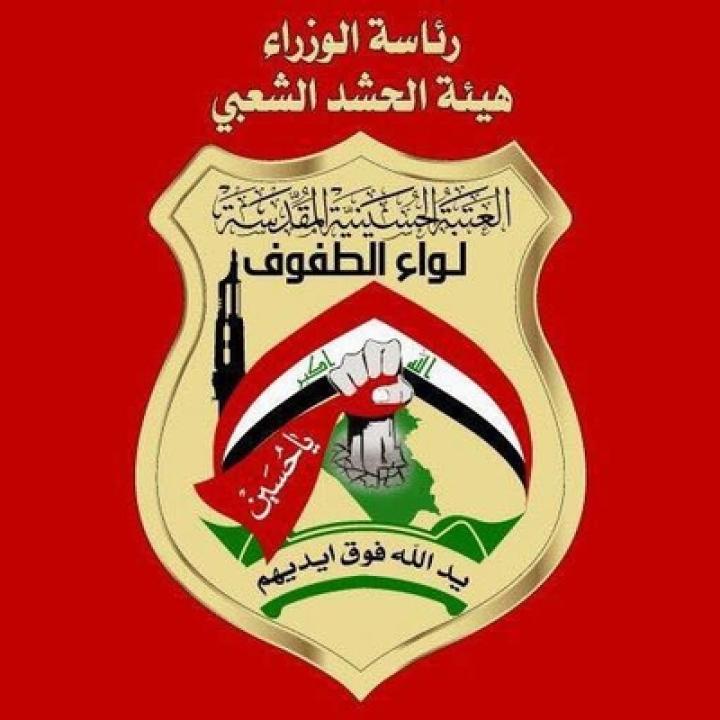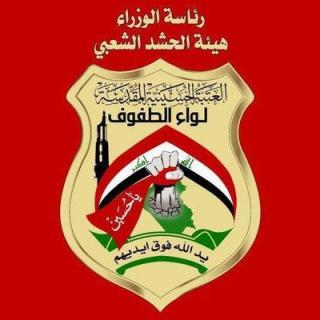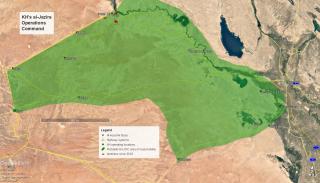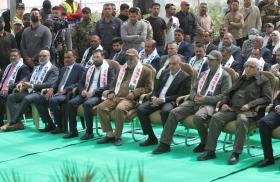
Profile: Liwa al-Tafuf (13th PMF Brigade)
Feb 3, 2024
Also available in

About the Authors
Brief Analysis
Part of a series: Militia Spotlight: Profiles
or see Part 1: How to Use Militia Spotlight: Profiles
The brigade belongs to the state-funded Popular Mobilization Forces and is a core member of Kataib Hezbollah’s cluster of militias that facilitate anti-U.S. attacks in Iraq’s Anbar province, eastern Syria, and Jordan.
Name: Liwa al-Tafuf
Type of movement: Tier 2 fasail (armed group). Logistical and administrative support to kinetic military operations against U.S. forces (in Iraq, Syria, and Jordan).
History and objectives:
- The PMF’s 13th Brigade (Liwa al-Tafuf) was formed by splintered-off commanders from the Ali al-Sistani–loyalist PMF 11th Brigade (Liwa Ali al-Akbar) in 2014. The new brigade was formed around a former head of security for the Karbala shrines named Qasim Muslih. Liwa al-Tafuf retained some support and drew some legitimacy from being connected to the shrines and to Sistani, but it quickly ceased to be a real “atabat” (shrine) PMF unit and instead fell increasingly under the administrative influence and operational control of Kataib Hezbollah founder and U.S.-designated terrorist Abu Mahdi al-Muhandis, then operational commander of the PMF.
- Liwa al-Tafuf (and its leader Qasim Muslih) became famous for salvaging armored vehicles from old tank graveyards and returning them, with ingenious new modifications, to service. The brigade fought in battles in Bayji, southern Nineveh, and on the Nineveh-Syria border during the PMF’s western Nineveh operation that paralleled the Mosul city liberation.
- Then, Liwa al-Tafuf was sent to take part in the expulsion of the Islamic State from Anbar, at al-Qaim, along the Syria-Iraq border to Akashat, and all the way to the Iraq-Syria-Jordan triborder. It settled down along the border and garrisoned (since 2017) the border line from the triborder to Akashat to al-Qaim, including the H-3 air base (renamed al-Mursinat). Liwa al-Tafuf guarded the new border crossing at Akashat that was developed to bypass the U.S. garrison at al-Tanf, Syria, which blocked the existing Iraq-Damascus highway.
- Qasim Muslih also retained a security role in Karbala in parallel to these Liwa al-Tafuf military campaigns, running drug-smuggling and assassination cells. He became increasingly unpopular with Sistani’s network of clerics and was encouraged to spend more time in Anbar, and was then given additional responsibilities in Anbar by the U.S.-designated terrorist Abu Mahdi al-Muhandis. Muslih was named head of the al-Qaim-based PMF Western Anbar Operations Command and its subsector in Rutbah. Liwa al-Tafuf was criticized by al-Qaim tribes over longstanding claims of land confiscation and unauthorized land and housing use by the militias, and the brigade was asked by local tribes to leave the district on multiple occasions in 2017–2020.
- Qasim Muslih and Liwa al-Tafuf accelerated their role in enabling Iranian cross-border weapon shipments to Syria and Lebanon. Muslih was issued a Syrian government identification card by Iran’s Islamic Revolutionary Guard Corps to enable fluid cross-border movement, and he was given a special role in facilitating the build-out of the IRGC’s Imam Ali camp near the al-Qaim border crossing in the Syrian district of Abu Kamal.
- In May 2019, a video emerged claiming the establishment of the so-called Free Revolutionaries Front, which featured several individuals with blurred faces but set against the flags of the Hashd and multiple PMF factions: specifically, Liwa al-Tafuf, Asaib Ahl al-Haq, Saraya Ashura, Saraya Talia al-Khurasani, Kataib Sayyid al-Shuhada, Kataib Jund al-Imam, the Badr Organization, Kataib Hezbollah, Kataib al-Imam Ali, and Saraya al-Salam. In the video, the speaker declared the factions’ unity to confront the U.S. presence and called on Iraqis to join the front.
- On September 22, 2019, an unknown party (probably Israel) launched an airstrike on a Liwa al-Tafuf outpost near Akashat. This was probably related to use of the post as a transfer point for Iranian advanced conventional weapons entering Syria via Iraq.
- In 2019–2021, Qasim Muslih was tasked by Kataib Hezbollah with countering civil society activists in Karbala and (due to his success there) other southern Iraqi cities. His brothers Ali and Hassan were key lieutenants in the assassination campaign. As the New York Times reported in May 2021, quoting one local activist: “The Liwa al-Tafuf brigade is the one who is killing activists, including Ehab al-Wazni, the lead coordinator of the protests in Karbala, and prior to that, the novelist Alaa Mashzoub and the activist Fahm al-Tai.”
- In May 2021, Qasim Muslih was arrested by Iraqi security forces for the May 9, 2021, assassination of protest leader Ehab al-Wazni in Karbala following public pressure on the government in the form of civil society’s “Who killed me?” hashtag campaign and protester attacks on the Iranian consulate in Karbala. Kataib Hezbollah pressure on Iraqi judges resulted in the release of Muslih afterward, and he returned to his command in al-Qaim.
- In June and July 2021, Muslih coordinated with Kataib Hezbollah and Kataib Sayyid al-Shuhada to facilitate a KSS multiple-rocket strike on U.S. forces at al-Asad Air Base (on July 7, 2021).
- In 2023–2024, Qasim Muslih and his Liwa al-Tafuf forces have facilitated multiple attacks on U.S. bases in Iraq (al-Asad), Syria (al-Tanf), and Jordan (Rukban) by Kataib Hezbollah and Ansar Allah al-Awfiya (19th PMF brigade), both of which were included (in November 2023) by KH’s Abu Hussein in a select list of “the Mujahedin brothers who participated in military jihad operations.”
- On February 2, 2024, Liwa al-Tafuf locations in Akashat were struck by the U.S. military in relation to the above facilitation of terrorist activities.
Chain of command:
- Iran. There is clear and convincing evidence that Liwa al-Tafuf and its commander, Qasim Muslih, are subordinate to and partly financed by the IRGC Qods Force (IRGC-QF). The preponderance of evidence shows that Iran involves the group in the development of IRGC sites inside Syria, most prominently the Imam Ali base in Abu Kamal. Liwa al-Tafuf units in Syria are under the direct operational and administrative control of the IRGC-QF.
- Partly financed by the Iraqi state. Liwa al-Tafuf operates the state-funded PMF 13th Brigade. Chain of command nominally runs through the Popular Mobilization Commission of the Prime Minister's Office and up to the prime minister. In practice, Liwa al-Tafuf PMF units frequently disobey the Iraqi government chain of command – for instance by executing independent foreign policy and unauthorized deployments within Syria - while legally remaining organs of the Iraqi state.
- Kataib Hezbollah’s Jazira Operations Command. A preponderance of evidence suggests that Liwa al-Tafuf and its commander, Qasim Muslih, are subordinate to Kataib Hezbollah’s Jazira Operations Command, which overlaps entirely the area of responsibility of the PMF Western Anbar Operations Command, and is recognized by Liwa al-Tafuf and Qasim Muslih as the direct, superior headquarters of the PMF Western Anbar Operations Command. Liwa al-Tafuf and Qasim Muslih facilitate terrorist actions undertaken against U.S. forces by the Kataib Hezbollah forces of the Jazira Operations Command.
Affiliate relationships:
- “Axis of resistance” forces in Syria. Since July 2019, Liwa al-Tafuf has undertaken civic works in the Abu Kamal area in eastern Syria to restore water networks in coordination with the Syrian army and Syria-based Iranian forces. Qasim Muslih frequently crosses into the Abu Kamal area using Syrian identity cards.
- Other IRGC-QF–linked militias. Liwa al-Tafuf has a clear and convincing record of cooperation within Anbar province and inside Syria with Harakat al-Abdal (PMF Brigade 39), Saraya al-Jihad (PMF Brigade 17), and the less capable Liwa al-Muntadher (Brigade 7), Ansar Allah al-Awfiya (Brigade 19), Saraya Ansar al-Aqidah (Brigade 28), Kataib Ansar al-Hujja (Brigade 29), Quwat al-Shahid al-Sadr al-Awal (Brigade 25), Quwat al-Shahid al-Sadr (Brigade 35), and Kataib al-Tayyar al-Risali (Brigade 31). Also, Liwa al-Tafuf’s training depot in Karbala has graduated Saraya al-Khurasani fighters.
Subordinate elements:
- In addition to its main regiments, Liwa al-Tafuf operates a regiment of local Sunni auxiliary militiamen from Anbar called Fawj Dir al-Qaim. Within al-Qaim, local Sunnis employ the protection services of Liwa al-Tafuf and align with them in order to reduce mistreatment from other PMF militias that are moving through and using the district.








